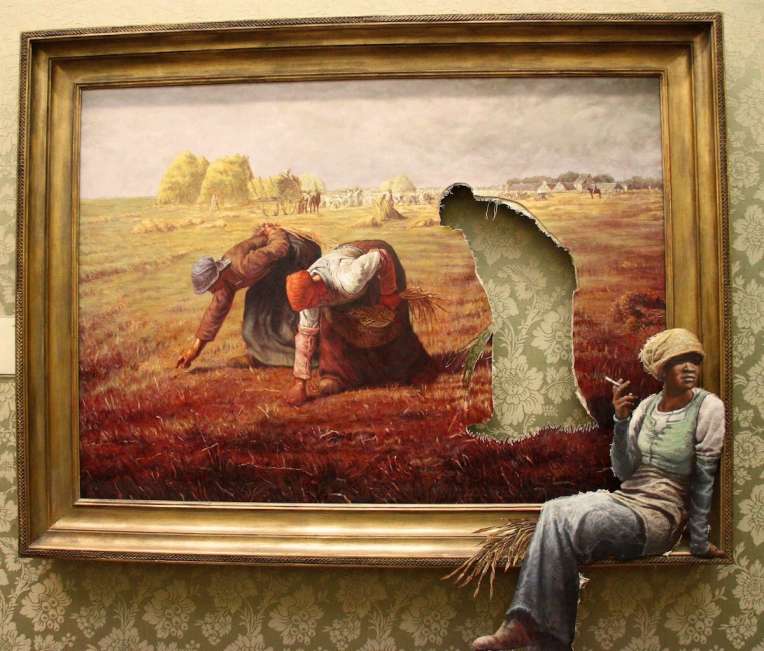Gleaning
From the Series: Temporary Possession
From the Series: Temporary Possession

Among the customary use rights that were displaced by industrial modernity, the right to glean is one of the more fascinating. In ancient and feudal societies around the world, commoners—particularly the poor, the young, the old, and women—were allowed to enter a field after the crop had been harvested and pick up what was left behind. Preindustrial harvesting techniques often left wastage, grains or grapes that were missed or dropped, and the labor-intensive work of gathering these was left to gleaners. Though in historical practice gleaning has ranged from a practice of charity to a form of labor organization, it is embedded in a Judeo-Christian ethics of redistribution. Some of the clearest traces of the practice appear in the Hebrew Bible, where gleaning is described as an obligation of the landowner to leave something behind “for the poor and the alien.” In Deuteronomy, gleaning appears among the laws set out for the people of Israel:
When you reap your harvest in your field and have forgotten a sheaf in the field, you shall not go back to get it; it shall be for the alien, for the orphan, and for the widow.
And in Leviticus:
When you reap the harvest of your land, you shall not reap to the very edges of your field, or gather the gleanings of your harvest.You shall not strip your vineyard bare, or gather the fallen grapes of your vineyard; you shall leave them for the poor and the alien: I am the Lord your God.
These Biblical commandments outline the complex concept at the heart of gleaning: the remainder. Notice how gleanings are constructed in these passages—they are a leftover, at once accidental (forgotten sheaves) and intentional (the landowner is obliged to forget). It’s an odd form of redistribution—the landowner doesn’t directly distribute a portion of the harvest but relies on a kind of fictive contingency. This contingency, I suggest, is key. The ostensibly accidental nature of the remainder allows gleaners access to the fruits of the land, but, crucially, without disturbing the landowners’ claim to the main harvest.

Gleaning declined across Europe over the nineteenth century, gradually displaced by modern agricultural technologies and increasingly exclusive conceptions of property. The combine harvester, for instance, radically reduced what was left for gleaners. Simultaneously, ideological shifts turned leftover into surplus—that is, into a remainder that should be enclosed and reinvested. As early modern configurations of property became more rigid, the complex and overlapping “fringe rights” (Thompson 1991, 288) that regulated villagers’ access to resources were progressively thinned. But neither agricultural gleaning nor the ethical obligation that is constituted through remainder have disappeared. Gleaning remained widespread through the mid-twentieth century at a smaller scale, and it continues in agricultural spaces around the world.1 In parts of rural East Africa, where I do research, gleaning is extensively practiced. Like its historical forms, this contemporary gleaning is governed by rules about who can glean, when, and what. For instance, children (but only children) can pick up leftover maize cobs after a harvest or gather stray coffee beans from the ground after sacks have been loaded onto a truck; the fact that this practice is rule-bound and reserved for certain categories of people speaks to a redistributive ethics persistent within it.2 The ethical structure of gleaning is also visible in nonagricultural spaces: fuel siphoners in other parts of East Africa draw on the concept of the leftover—and the obligation of the rich to leave one—in constructing their right to glean fuel (Bize 2018). And as Xenia Cherkaev writes, the injunction to leave a remainder continues to be activated even within financial capitalism.
These scattered examples speak to the ongoing role of the remainder within marginal practices of redistribution. But gleaning is also making a comeback at the heart of large-scale capitalist agricultural production, in ways that both resemble and depart from traditional gleaning. Across Western Europe and the United States, where agriculture is dominated by large farms, faith-based and food justice movements are using gleaning (glanage, Nachlese, espiga) to describe their efforts to gather crops left in the fields—often “ugly” crops that farmers don’t find cost-effective to harvest, or a surplus that won’t find a market. These movements draw their ethical force not from the obligation to leave a remainder, but from the obligation to distribute and use it: they point to the immorally large heaps of waste associated with late capitalist production and distribution processes. Gleaning, here, describes a practice of revaluing for use the rejects of exchange; gleanings are appropriated less as leftovers than as waste.
These contemporary gleaners suggest (for good reason) that their practices are just because they both redistribute resources and revalue waste: the gleaner preserves the use value of the fallen grapes. But I want to suggest that, in its original form, gleaning does not draw on a framework in which morality is embedded in use as opposed to exchange, just as usufruct does not necessarily imply the triumph of use value over exchange value. In fact, it’s not about the morality of use at all. Gleanings are constructed as a remainder because this creates a space of exception that (contingently) releases products from their existing structures of belonging. Jacques Derrida’s (2005, 151) thoughts on the remainder are useful here: “the remainder is not, it is not a modification of what is . . . the remaining offers itself for thought before or beyond being.” The role of the remainder in gleaning is to destabilize ownership by decentering being itself.
One who gleans takes without taking, and this is how the outsider gains access to resources in contexts of established inequality. Among other things, then, remainder might point toward a construction of economic justice that does not hinge on the classical use–exchange distinction but rather on the question of the exception, with both its possibilities and its limits.
1. In Germany, France, and England, a practice of gleaning survives in living memory, animated by memories of hunger after World War Two.
2. Many thanks to Kevin Donovan for describing the gleaning of coffee beans in Chepkube.
Bize, Amiel. 2018. “Black Spots: Roads and Risk in Rural Kenya.” PhD dissertation, Columbia University.
Derrida, Jacques. 2005. Paper Machine. Translated by Rachel Bowlby. Stanford, Calif.: Stanford University Press. Originally published in 2004.
Thompson, E. P. 1991. “The Grid of Inheritance.” In Making History: Writings on History and Culture, 287–315. New York: The New Press.